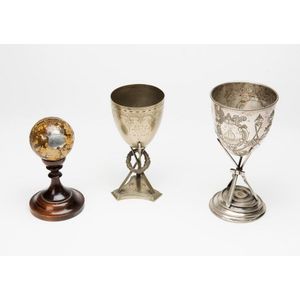Art Nouveau Silver Chalice with Tulip Design
You must be a subscriber, and be logged in to view price and dealer details.
Subscribe Now to view actual auction price for this item
When you subscribe, you have the option of setting the currency in which to display prices to $Au, $US, $NZ or Stg.
- Chalice - A chalice is a large cup or goblet that is used in religious ceremonies, particularly in Christian liturgical traditions. It is typically made of precious metal such as gold or silver, and is used to hold wine during the Eucharist, which is the central sacrament of the Christian Church. The chalice is also called the "cup of salvation" and is a symbol of Jesus' sacrifice on the cross.
In the Christian tradition, the chalice is a symbol of the blood of Jesus Christ, which is offered to the faithful as a means of grace and salvation. The chalice is used to hold the wine that is consecrated during the Eucharist and is considered to be a sacred object.
In the liturgical celebration of the Eucharist, it's passed around to the faithful, and the believer drinks from it to partake in the sacrament. Chalices are also used in other liturgical celebrations such as baptism, confirmation and anointing of the sick.
Chalices come in different shapes and sizes, from simple cups to highly ornate and decorative vessels, some of them are adorned with precious stones and intricate engravings. Chalices can also be used for other purposes, such as for holding holy water for baptism, or for the distribution of ashes on Ash Wednesday. - Art Nouveau Period - The Art Nouveau period was a cultural movement that emerged in the late 19th century, and was characterized by its emphasis on natural forms, flowing lines, and a decorative, ornamental style. Art Nouveau was a reaction against the ornate and heavily stylized designs of the previous era, and sought to create a new, more organic aesthetic.
Art Nouveau was characterized by its use of sinuous, curving lines, as well as a focus on natural elements such as flowers, vines, and other organic shapes. Art Nouveau designers sought to create a total work of art, in which every element of a building or object was designed to be harmonious with the overall design.
Some of the most iconic examples of Art Nouveau design include the Paris Metro entrances designed by Hector Guimard, the works of the artist Alphonse Mucha, and the architecture of Victor Horta in Brussels.
The Art Nouveau period was at its peak between 1890 and 1910, but began to decline in popularity by the start of World War I. However, Art Nouveau remains an important influence on design and art to this day, and continues to be celebrated for its emphasis on natural forms and decorative style. - Hallmarks - A mark stamped on articles of precious metals in Britain, since the 14th century, certifying their purity. It derives its name from the Guild Hall of the Goldsmiths' Company, who recieved its Charter in 1327 giving it the power to assay (test the purity) and mark articles of gold and silver.
The hallmark will consist of several marks, including the:
- silver standard mark, indicating the purity of the metal. Sterling silver is .925 pure silver.
- the city mark indicating the city in which it was assayed eg London, Birmingham, York etc.
- the date mark, usually a letter of the alphabet in a particular font and case,
- a duty mark, indicating whether duty had been paid to the crown, and only in use from 1784 to 1890
The piece may include an additional mark, the maker's mark, although not forming part of the hallmark, will be located in the vicinity of the hallmarks.
Sometimes silver plated items will bear faux hallmarks, often confusing those not familiar with silver markings. - Sterling Silver - Sterling silver is a mixture of 92.5% pure silver and 7.5% of another metal, usually copper. Fine silver is 99.9% pure silver, and is relatively soft and the addition of the very small amount of copper gives the metal enough strength and hardness to be worked into jewellery, decorative and household objects.
- Chasing - The method of decorating gold and silver objects using a punch and hammer so that the design appears in relief. Flat or surface chasing is done from the front giving the item definition, but not cutting into the metal.
Chasing is the opposite technique to repousse, but an object that has repousse work, may then have chasing applied to create a finished piece.
This item has been included into following indexes:
Visually similar items

Trophies: 1880 Yarra Yarra Rowing club trophy (cup on crossed oars), 1928 Apdc Presidents cup (cup with engraved yacht on crossed oars), plus 1938 hockey trophy (shield on hockey ball).

A Tasmanian fiddleback blackwood comport and a fiddleback blackwood and cedar goblet, 18 cm and 9.5 cm high

Pair George V hallmarked sterling silver stemmed dishes. Birm.1910, makers Elkington. Height 13 cm (each) Wt. 364g (total)

A George III silver goblet, plain ovoid bowl with gilded interior, the spreading circular foot with reeded rim, scripted initials. London 1802 by Peter, Ann & William Bateman. Weight 168gms. Height 15 cm
